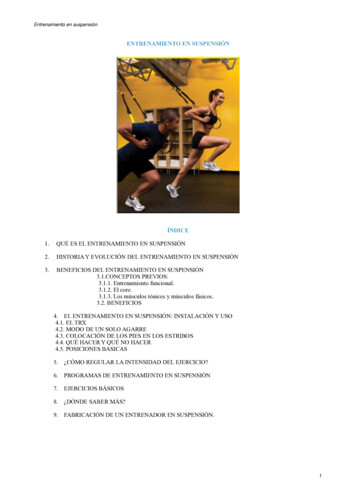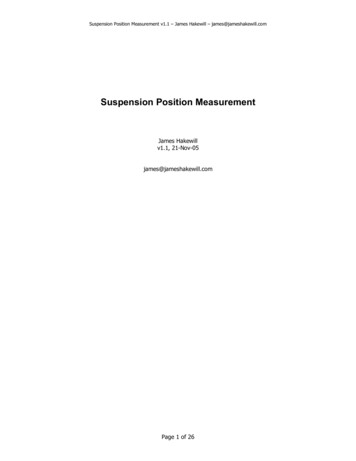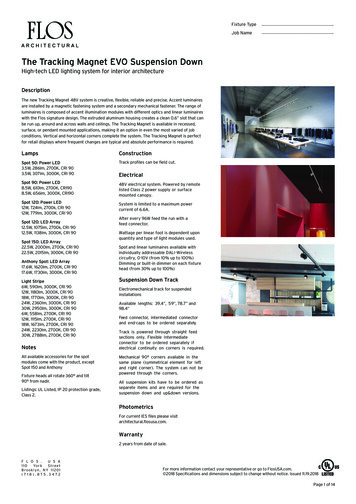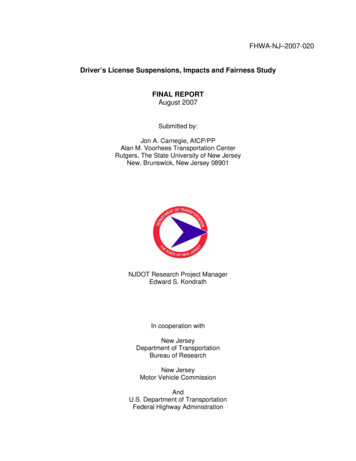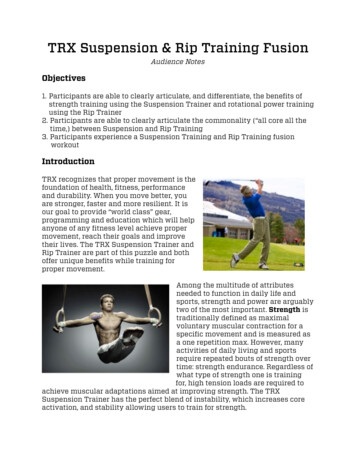
Transcription
TRX Suspension & Rip Training FusionAudience NotesObjectives1. Participants are able to clearly articulate, and differentiate, the benefits ofstrength training using the Suspension Trainer and rotational power trainingusing the Rip Trainer2. Participants are able to clearly articulate the commonality (“all core all thetime,) between Suspension and Rip Training3. Participants experience a Suspension Training and Rip Training fusionworkoutIntroductionTRX recognizes that proper movement is thefoundation of health, fitness, performanceand durability. When you move better, youare stronger, faster and more resilient. It isour goal to provide “world class” gear,programming and education which will helpanyone of any fitness level achieve propermovement, reach their goals and improvetheir lives. The TRX Suspension Trainer andRip Trainer are part of this puzzle and bothoffer unique benefits while training forproper movement.Among the multitude of attributesneeded to function in daily life andsports, strength and power are arguablytwo of the most important. Strength istraditionally defined as maximalvoluntary muscular contraction for aspecific movement and is measured asa one repetition max. However, manyactivities of daily living and sportsrequire repeated bouts of strength overtime: strength endurance. Regardless ofwhat type of strength one is trainingfor, high tension loads are required toachieve muscular adaptations aimed at improving strength. The TRXSuspension Trainer has the perfect blend of instability, which increases coreactivation, and stability allowing users to train for strength.
Conversely, Power is force multiplied bydistance and divided by time (thus,power training involves lighter loadsand faster movement speeds.) The TRXRip Trainer provides lighter loads at theinitial range of motion allowing users toaccelerate the Rip Trainer at high ratesof speed promoting power. Additionally,controlling and producing rotation iscritical to proper movement. RipTraining challenges the user to eithercontrol or produce rotation in everyexercise.Power Force X DistanceTimeCommon GroundProper posture is essential in activities of daily living and in sports. Posturalfaults that persist can give rise to discomfort, pain or disability (Kendall, et al.1983.) Core muscle activation is essential for the maintenance of properposture. At TRX we employ the following mantra for movement training “allcore, all the time.” Both the Suspension and Rip Trainer challenge posture onevery exercise which forces the core to engage. While thinking about coremuscle activation it is important to consider the concept described by JamesDexter: “masses and spaces.” This concept defines the head, chest and hips asmasses and the neck and waist as spaces. Common postural faults (forwardhead, forward shoulders, posterior pelvic tilt, etc.,) demonstrate diminishedspaces between the masses. Maintaining proper posture, “masses & spaces,”and core activation accomplishes several things: enhanced power transfer mitigation of injuries improved balance improved aesthetics
Suspension Training Variables (6/6/3)Prior to engaging in Suspension Training it is important to understand the 6positions, 6 procedures and 3 principles of progression. The positions refer tobody orientation relative to the anchor point and describe if the user is facing,facing away or facing sideways to the anchor point. The procedures identifyhow to adjust the straps and where to place the hands or feet for specificexercises. The three principles of progression are extremely important as theyallow users to modify load or intensity for any goal. Following is a briefdescription of the three principles of progression.VECTOR RESISTANCE PRINCIPLEFor most standing movements, positioning your feet closer to the anchor pointwill increase resistance and heighten the challenge. Stepping farther awayfrom the anchor point will decrease resistance and make movements easier toexecute. Note the below images: the image on the right highlights the athletesuse of a steeper angle (feet closer to the anchor,) increasing difficulty.EasierHarderPENDULUM PRINCIPLEFor ground-based movements, moving your feet away from the anchor pointwill increase resistance and heighten the challenge. Moving your feet towardsthe anchor point or behind the anchor point will decrease resistance and makemovements easier to execute.STABILITY PRINCIPLEIn general, performing movements with a narrower base of support orunilaterally (using just one arm or just one leg instead of both arms or bothlegs) will increase the challenge of TRX movements. The wider your base ofsupport, the more stable you will be during TRX movements and the lesschallenging they will be to perform.
Rip Training VariablesSimilar to Suspension Training, Rip Training has several variables whichshould be understood prior to using the system. Modifications in handposition, foot position, bar paths, bar targets, types of movement andmovement speed can be used to obtain different functional outcomes. Themost important thing to know in regards to Rip Training is how to adjust theintensity. There are two primary ways to modify intensity while TRX RipTraining. The TRX Vector Resistance Principle and the Stability Principlesummate to create increased or decreased intensity while Rip Training.The Vector Resistance Principle highlights the magnitude and direction ofapplication of force. In simple terms, the principle describes how load can bemodified to progress or regress Rip Training exercises. There are four ways tomodify load using the Vector Resistance Principle: Body position relative to the anchor (the closer one is to the anchor thelighter the tension on the resistance cord and the easier the exercise) Hand position on the Rip Trainer (the further thehands are from the resistance cord, the lessleverage users have increasing difficulty) Bar position relative to the body (the further theresistance cord end of the bar is from the body, the greater the loadtransmitted through the body and harder the exercise: see figures below)EasierHarder Resistance cord level (there are 5 different resistance cord levels rangingfrom (light 12 lbs,) to (XX-Heavy 56 lbs.) the heavier the cord the greater theintensity.The ability to modify load and progress or regress Rip Training exercises in“real time” is an important feature of the Rip Training system. Modificationsallow users to change intensity for increased challenges or to reduce loadensuring proper form and mechanics of motion.
The TRX Stability Principle refers to the relationship of one’s center of gravity(C.O.G.,) relative to their base of support. Generally, the lower one’s C.O.G. andwider their base of support, the more stable they are. For instance a footballlinebacker getting ready to tackle an oncoming running back, widens theirstance and lowers their hips to promote stability and to prepare for impact.Foot position can be modified in “real time” to create increased or decreasedchallenges to Rip Training exercises. Often times narrower stances and higherC.O.G. body positions are used to challenge core stability and progressexercises while Rip Training (see figures).EasierHarderKeep in mind that although wider foot positions and lower C.O.G. bodypositions generally decrease intensity, they can be used to create a morestable platform for power production; subsequently, if the user is in a lowstance and working with high velocity movement patterns, intensity can stillbe quite high.ConclusionTRX is dedicated to scientific research and application in the field of healthand fitness. We believe that by applying “best practices” to movement basedtraining, we can positively impact functional outcomes. We also aim to“democratize” world class training such that anyone at any age can haveaccess to the best gear, programming and education the industry has to offer.TRX Suspension and Rip Training are valuable movement training tools whichaddress strength, power, balance and overall athleticism. Incorporating TRXtraining into your strength and conditioning program will improve functionaloutcomes and is a novel way to approach overall health and fitness.
TRX Suspension & Rip Training Fusion Workout
The TRX Rip Trainer provides lighter loads at the initial range of motion allowing users to accelerate the Rip Trainer at high rates of speed promoting power. Additionally, . modified to progress or regress Rip Training exercises. There are four ways to modify load using the Vector Resistance Principle: Body position relative to the .




